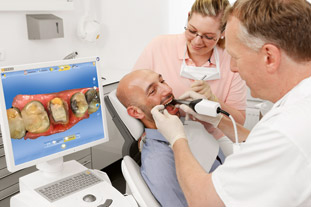 The side effects of chemotherapy are known to be damaging on the entire body, and that includes the mouth. And to make matters worse, some of the harmful effects on the mouth caused by chemotherapy can cause your doctors to delay or stop treatment completely. This is why it is of utmost importance, when possible, to visit the dentist one month prior to beginning chemotherapy, allowing ample time to detect and correct any serious oral health problems before undergoing treatment.
The side effects of chemotherapy are known to be damaging on the entire body, and that includes the mouth. And to make matters worse, some of the harmful effects on the mouth caused by chemotherapy can cause your doctors to delay or stop treatment completely. This is why it is of utmost importance, when possible, to visit the dentist one month prior to beginning chemotherapy, allowing ample time to detect and correct any serious oral health problems before undergoing treatment.
Possible Side Effects
The chemotherapy drugs used to treat cancer not only kill harmful cancer cells, they also do devastating damage to normal, healthy cells. When the cells in the mouth become damaged by chemotherapy, the teeth, gums, and glands can all be negatively affected, too. This can lead to burning sensations, swelling, dry mouth, mouth sores, changes in taste, and trouble chewing, swallowing, and talking. It can even make you more prone to infection.
Tips for a Healthy Mouth
In addition to visiting the dentist prior to beginning treatment, and then continuing to visit the dentist regularly during treatment, there are some things you can do yourself to help maintain a healthy mouth.
One very important thing you can do at home is to check your mouth every day for sores and other changes. You should also drink plenty of water and even suck on ice chips to help keep your mouth moist.
If your mouth is sore, then use an extra-soft bristle toothbrush—you can also run warm water over the bristles before use to help soften them even more. You’ll also want to floss gently each night. If you experience pain or bleeding gums in certain areas, then it is a good idea to avoid those areas but continue to floss the other teeth in the mouth. Finally, rinse your mouth several times a day with a solution of ¼ teaspoon baking soda and ¼ teaspoon salt in 1 quart of warm water.
It’s also best to avoid using toothpicks and tobacco. You should not consume alcohol either, and try not to eat foods that are sharp, sugary, and/or difficult to chew or swallow. Instead, eat soft and moist foods whenever possible, and be sure to take small bites. Consuming liquids while eating will also make chewing and swallowing easier and less painful.
Conclusion
When you experience pains or sores in and around the mouth, contact your doctor. He/she will be able to prescribe certain medications to help control the pain.
Unfortunately, not all mouth problems can be avoided while undergoing chemotherapy. However, it is still in your best interest to allow your dentist to be an active part of your cancer treatment. It is also a good idea to put your dentist in contact with your other doctors, so that the best treatment options can be discussed and realized as a team. After all, the fewer side effects you experience, the more likely your cancer treatment schedule will continue according to plan.


 Research shows that in recent years the amount of
Research shows that in recent years the amount of  Lloyd’s of London
Lloyd’s of London
You must be logged in to post a comment.